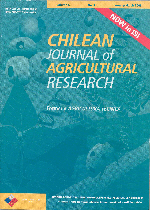
|
Agricultura Técnica
Instituto de Investigaciones Agropecuarias, INIA
ISSN: 0365-2807
EISSN: 0365-2807
Vol. 61, No. 4, 2001, pp. 479-487
|
 Bioline Code: at01050
Bioline Code: at01050
Full paper language: Spanish
Document type: Research Article
Document available free of charge
|
|
|
Agricultura Técnica, Vol. 61, No. 4, 2001, pp. 479-487
| en |
Effect of Four Different Levels of Water Application on Yield and Quality of Greenhouse Tomatoes (Lycopersicon EsculentumMill. cv. FA-144) Produced in Autumn
Opazo, José Domingo A. & Razeto, Bruno M.
Abstract
A study was carried out from January to July 1997 in a greenhouse
at the Panguilemo Experimental Station of the University of Talca, Chile
(35°23' S lat, 71°40' W long, 110 m.s.n.m) to evaluate
the effect of different levels of irrigation water on the yield and quality
of tomatoes (
Lycopersicon esculentum
Mill.) cv. FA-144. The drip irrigation treatments were the application of
70% (T1), 100% (T2) and 150% (T3) of the real crop evapotranspiration (ETreal)
and the control was the irrigation level that farmers usually apply in the
region. The ETreal was estimated using the evaporation of a modified tray
(diameter = 50 cm and depth = 25 cm), whose values were corrected by a local
tray coefficient and the tomato crop coefficient. The results indicated
that the total yield decreased with lower quantities of water with the highest
production being reached by T3 and the control. Furthermore, fruit size
was significantly larger with T3 than with the other treatments. Regarding
the diameter, average weight and dry matter percentage no significant differences
were observed among the treatments. On the other hand, soluble solids and
fruit pulp pressure increased significantly with the reduction of water.
Keywords
irrigation, crop evapotranspiration, soluble solids, fruit pulp pressure
|
| |
| es |
Efecto de Cuatro Láminas de Agua Sobre el Rendimiento y Calidad de Tomate (Lycopersicon EsculentumMill. cv. FA-144) de Invernadero Producido en Otoño
Opazo, José Domingo A. & Razeto, Bruno M.
Resumen
Se realizó una investigación en la Estación
Experimental Panguilemo de la Universidad de Talca (35°23' lat.
Sur, 71°40' long. Oeste, 110 m.s.n.m) con el objeto de evaluar
el efecto de cuatro láminas de agua sobre el rendimiento y calidad
de un cultivo de tomates (
Lycopersicon esculentum
L.) cv. FA-144, regado por cintas, durante los meses de enero a julio de
1997. Los tratamientos correspondieron a una reposición de 70, 100
y 150% de la evapotranspiración real (ETreal), T1, T2 y T3, respectivamente,
y un testigo que correspondió a las láminas de agua que el agricultor
utiliza tradicionalmente en la zona. La ETreal del tomate se estimó
usando la evaporación de una bandeja modificada (diámetro = 50
cm y altura = 25 cm), cuyos valores fueron corregidos por un coeficiente
de bandeja local y el coeficiente de cultivo del tomate. Los resultados
de este estudio indicaron que el rendimiento total y comercial disminuyó
a medida que se aplicaron cantidades de agua menores, siendo el testigo
y el tratamiento de 150% de la ETreal (T3) los que alcanzaron las mayores
producciones totales. Por otra parte, la producción de frutos de calibre
extra y primera fue significativamente superior en T3 que en el resto de
los tratamientos. En cuanto al diámetro ecuatorial y polar, y peso
promedio, no se observaron diferencias significativas entre las distintas
láminas de agua evaluadas; similar situación se observó en
el porcentaje de materia seca. Por otro lado, los sólidos solubles
y presión de pulpa de los frutos aumentaron significativamente con
la reducción del agua.
Palabras-clave
riego, evapotranspiración de cultivo, sólidos solubles, presión de pulpa de fruta.
|
| |
© Copyright 2001 - Instituto de Investigaciones Agropecuarias, INIA (Chile)
Alternative site location: http://www.inia.cl/at/agritec.htm
|
|
